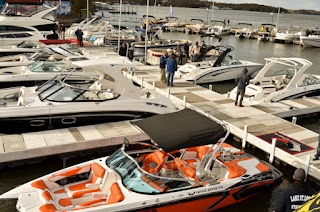Michigan’s Famous Christmas Tree Ship
LAKE MICHIGAN – The shipwreck legend of Michigan’s famed “Christmas Tree Ship” remains shrouded in equal parts myth and mystery. But what we do know is this: 108 years ago today, that worn-out schooner helmed by a man nicknamed “Captain Santa” and weighed down heavily by a load of U.P. Christmas trees bound for Chicago was fighting a mighty battle against intensifying winds and waves of a coming storm.
In their final minutes, the Rouse Simmons’ crew had thrown out the schooner’s port anchor into Lake Michigan, hoping to hold her into the wind, archeologists later discovered. In the words of the dive team who pieced together her last tragic moments: “something had gone seriously wrong aboard the vessel.”
Overcome by large waves, the three-masted schooner went down hard on the afternoon of Nov. 23, 1912, her bow leaving a 10-foot-deep gash in the bottom of Lake Michigan. Lost with her were 16 souls – her captain, crew, and a group of lumberjacks who were hitching a ride to the Windy City so they could get home for the holidays.
For years after her sinking, Christmas trees washed up on the shores of Lake Michigan. Divers a century later found her cargo hold still packed with Christmas trees, some with needles still intact.
After all these years, the wreck of the Christmas Tree Ship remains a sentimental favorite among those who love Great Lakes lore. And while a 2006 dive exploration of the wreck by the Wisconsin Historical Society dispelled many myths surrounding the Rouse Simmons, some bits of mystery still cling to this tragic last voyage of a crew that had traditionally brought so much holiday joy to underprivileged children.
Before the Rouse Simmons was an aging, leaky boat known for ferrying Christmas trees across Lake Michigan, she was a sleek workhorse schooner on the Great Lakes.
Built in 1868 in Wisconsin, she became part of Muskegon lumber baron Charles Hackley's fleet and spent much of her early decades carrying wood from his mills to other ports. At one point, U.S. Customs records showed she was making nearly weekly runs from Grand Haven to Chicago, according to the National Archives.
By the turn of the century, she was showing signs of wear. Like many schooners, she’d changed hands and cargo more than a few times.
By 1910, Capt. Herman Schuenemann owned a small interest in her. For years his family had been among the two dozen schooner crews doing late-season Christmas tree runs, bringing evergreens from northern Michigan and Wisconsin to Chicago's docks.
The ships would be decorated with lights, and the families could come aboard and pick out an inexpensive tree. And the captains, by cutting out the retail middleman, could get a decent profit from a holiday run.
Known for his generosity, Schuenemann earned the nickname "Captain Santa."
"At some stage of Herman Schuenemann's long career as a late-season tree captain, he was given the title of Captain Santa. The affectionate nickname was bestowed by Chicago's local newspapers and by the city's grateful residents. Schuenemann's profits from selling Christmas trees had never made the family wealthy, but his reputation for generosity was well established, and he delighted in presenting trees to many of the city's needy residents. Schuenemann enjoyed the sobriquet and proudly kept newspaper clippings about his role as Captain Santa in his oilskin wallet."
When he set out for his late-season run in November 1912, researchers say the Rouse Simmons was one of only a handful of ships to attempt it that year. Schuenemann knew they could be deadly. His older brother, August Schuenemann, had died in a Christmas-tree hauling trip in 1898 when the schooner S. Thal sank in a storm.
With her cargo hold crammed with trees, and others stacked up to 8-feet-tall on her deck, some say the Rouse Simmons looked like a floating forest when she pulled away from Thompson, Michigan, near the Upper Peninsula's Manistique, on Friday, Nov. 22, 1912.
As she headed south toward Chicago, a storm was approaching Lake Michigan, packing gale-force winds and snow.
“While it will never be known for certain what transpired during the Rouse Simmons’ final moments.
Archeologists concluded it was likely a combination of large waves and its overload of cargo that sent the Rouse Simmons straight to the bottom.
“It’s also likely that the estimated eight feet of trees piled high on the deck destabilized the vessel. Some reports indicated the Rouse Simmons left Thompson, Mich., with less than a foot of freeboard under the weight of the trees. Those trees can still be found stacked neatly in the hold and, if you examine them closely, some of the trees located lower in the stacks still retain their needles,” the historical society reported. “The weight of the anchors and the chain piled on the deck contributed to the force with which the vessel struck the bottom. As the vessel hit bow first, causing a ten-foot deep divot in the sand bottom, the majority of her rigging was flung forward of the vessel where it lies on the lake bed, raking the chainplates forward, dislodging the fore and main masts and snapping the mizzen mast. Much of the hull remains intact with the exception of a few boards on her stern that were sprung as air evacuated the sinking hull.”
In the days following her disappearance, clues were slow to come. Christmas trees believed to be from the wreck washed up along the shores of Michigan and Wisconsin that December, and were brought up in fishing nets for years to come.
Then there was a message in a bottle, believed to be from the Rouse Simmons crew, that washed up in Sheboygan, Wis. The bottle was corked with a tiny piece of pine tree, according to research by Lori Jacobson-Tews.
The message read: "Friday ... everybody goodbye. I guess we are all through. During the night the small boat washed overboard. Leaking bad. Invald and Steve lost too. God help us."
The next clue was found in 1924, when Capt. Schuenemann's wallet came up in the net of a fishing trawler. Wrapped it oilskin, the wallet was well-preserved and was later returned to his family.
For years after the Christmas Tree Ship sank, the captain's wife, Barbara Schuenemann, and her daughters continued to sell evergreens along the Chicago pier. They initially used schooners, but soon switched to railcars and other transportation to get their trees.
In 1999, the U.S. Coast Guard and the Chicago maritime community revived this holiday tradition, bringing in trees from Northern Michigan. Chicago's Christmas Ship group selects the organizations that will get the trees to inner city children and their families.
To this day the tradition continues,The U.S. Coast Guard Cutter Mackinaw (WLBB-30) delivers Christmas trees from northern Michigan to Chicago every year as a part of Chicago’s Christmas Ship program. The one-of-a-kind icebreaker and its predecessor, USCGC Mackinaw (WAGB-83), have delivered more than 25,000 Christmas trees to Chicago families in the past 20 years. This photo shows the 2018 delivery. U.S. Coast Guard photo by Cmdr. John M. Stone.
Merry Christmas To All







Comments
Post a Comment